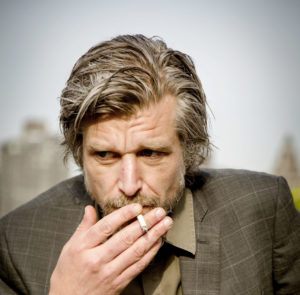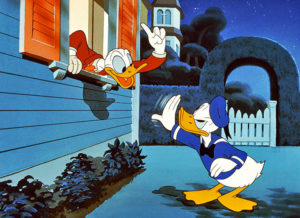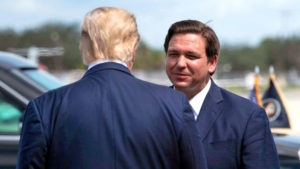In 1967, a year after the death of Walt Disney, construction began on the magnate’s signature project — Disney World. Located in the swamps of Central Florida, the resort — “the most magical place on earth” — opened in 1971. It signalled the arrival of the state’s most powerful political figure: Mickey Mouse.
The Walt Disney Company, founded in 1923 by Walt and brother Roy, was a formidable cultural force throughout its 50-year existence prior to the resort’s inception, but ownership of thousands of acres of Florida land and the unchecked power to shape it granted the corporation unprecedented control and room for continual expansion. The cultural force transformed into an American juggernaut.
To understand the scale and reach of Disney’s power in Florida, one only need look at the Reedy Creek Improvement District, the governing jurisdiction for the land on which Disney World is located. The district, created in 1967 by a special act of the Florida legislature, gave Disney World the power to operate like a county government. There, Disney World functions as its own mini-country in the state of Florida. Disney World has the authority to claim eminent domain and even build a nuclear power plant (pending federal approval); it also operates its own public utilities and has its own fire department.
The state of Florida handed Disney World a once-in-a-generation deal, but it also took much from the accord. In the pre-Disney days, there was no reason to stop in Central Florida, unless one wanted to do battle with a gator. The arrival of Disney World planted the seed for the Florida we know today, one that continually blossoms with the resort’s ever-expanding reach. It’s not an overstatement to say that Disney World opened up Florida to the rest of the country — and the world, for that matter — and that this symbiotic relationship seemed unbreakable.
For so long, you went to Florida to go to Disney, which is to say that Disney was Florida. To think that Disney World would one day become a culture war battleground and the decades-long arrangement destroyed was unthinkable, but the mouse would eventually meet its match in a fellow Central Floridian — Florida Governor Ron DeSantis.
In early June, through no fault of my own, I went to Disney World. My girlfriend’s family was making the annual trek to the mouse’s kingdom, so, like a good boyfriend, I donned the Mickey Mouse ears — for the amusement of the young children in our party, I told myself — and stepped into Magic Kingdom on a sweltering Florida morning. As a native Floridian, I’d grown up going to Disney. I understood why children loved Mickey Mouse and Donald Duck and Goofy and all the others, but I was confounded by the adults — some of them even seemed well-adjusted — who were obsessed with all things Disney.
These obsessives, pejoratively knowns as “Disney adults,” bankroll the entire operation. They construct their identities around their love of the mouse. How an adult can identify with a mouse or a dog or even a fairy is beyond me, but pathological fandom, especially when rooted in childhood nostalgia, will make even the most sensible person act irrationally.
Entering Magic Kingdom, Disney’s World’s flagship theme park, one immediately sees Cinderella’s castle in the distance. To a child, the castle is Cinderella’s actual home, but for the Disney adult it symbolises that they’ve finally arrived at their spiritual home. To a 30-something man like me, who is neither a Disney lover nor hater, the castle is a testament to the insane visionary genius of Walt Disney.
This one-time illustrator cooked up the idea to prop up a princess castle in Central Florida, and here we all are making a beeline for it. What’s even more impressive is that the castle really is beautiful, not kitsch. Looking at it for the first time in years, I thought of my parents and my sister — a Disney adult herself who identifies with Minnie Mouse — and of all the days we spent at the park.
Even though I knew I was being worked over by Walt’s nostalgia machine, I felt happy and wistful. Walt Disney figured out that everyone wants to return to a state of childhood innocence, and if he could tie the desire for that innocence to his brand — and even intertwine the two — he’d have an empire on his hands. For millions of people, returning to their childhoods means returning to Florida.
Dreams and nostalgia are tainted by overt politicisation, which is why Disney has always been crafty with their political postures and sloganeering. As I walked through the Magic Kingdom, aware that I was there during Pride Month and that the Walt Disney Company employs large numbers of LGBTQ people, I saw rainbow-coloured mouse ears and rainbow-coloured ice cream bars, but not much else. The stores selling Disney merchandise had a single Pride display with the rainbow ears and other pride-related items, but it didn’t draw attention to itself. This is how Disney likes to operate; the company has “pride” but not in an over-the-top way that alienates more conservative Disney adults. Disney mostly succeeded at keeping its Americana-styled aesthetics intact as its staff has grown increasingly progressive throughout the years.
Yet this delicate balancing act recently ended, when Florida Governor Ron DeSantis signed the Parental Rights in Education bill — better known as the “Don’t Say Gay” bill. Keeping as apolitical as possible, the Disney Company did not make an initial statement denouncing the bill, to the surprise of its progressive employees. They threatened a walkout, so Disney CEO Bob Chapek’s hand was forced; he attacked the bill, but employees, angered that the denunciation wasn’t forceful enough, walked out anyway.
DeSantis did not appreciate Disney’s condemnation and called out the company for its ties to communist China. A back and forth ensued, DeSantis setting his sights on bringing Disney down a peg. The Walt Disney Company was officially part of the culture war, and it was up against a confident and game Ron DeSantis.
The governor, unknown before the pandemic, was thrown into the national spotlight when the mainstream media positioned him as the antithesis of the pro-lockdown New York Governor Andrew Cuomo. When DeSantis refused to lock down Florida during its summer 2020 Covid surge, the media labeled him genocidal, and he was lambasted by critics as “DeathSantis”, but he didn’t change course.
In the end, as blue states clung to overextended lockdowns, DeSantis was vindicated; Florida’s death rate from Covid is comparable to California’s. DeSantis leaned hard into his newfound position as Republican saviour and has proceeded to shape Florida in his image ever since. With the influx of blue state refugees into the state and DeSantis’ sudden ascendance, Florida has entered a renaissance period. DeSantis has taken to calling the state “the free state of Florida”. It was only a matter of time before the state’s newest juggernaut came up against its original powerhouse.
DeSantis’ tussle with Disney World was a genuinely shocking moment. For one thing, it proved that the governor was not a PR-construct doing an impression of Donald Trump. In April of 2022, DeSantis made his move and signed a bill dissolving the Reedy Creek Improvement District; it goes into effect June 2023. Disney thought itself untouchable — and it had been for decades — but DeSantis slapped the mouse on the head. The message was clear: this is my state now.
This is the new Florida. The mouse is on the defensive, and the situation has only been made worse by the release of videos showing Disney employees discussing the incorporation of trans-inclusive characters and the like into new programming. Disney can no longer defend its apolitical position.
In 1965, Walt Disney called his plan to construct Disney World “The Florida Project”. Disney’s plan to transform the centre of the state, as well as its national brand, into an appendage of the mouse, was a resounding success. Walt Disney World is celebrating its 50th anniversary this year, but the company never expected that this would coincide with the possible end of “The Florida Project”.
Today, Governor Ron DeSantis and his project of rebranding Florida is now the state’s most formidable force. In a recent interview with Dave Rubin, DeSantis couldn’t have made it any clearer where he stands on the mouse: “I did not take an oath to subcontract my leadership to some corporation in Burbank, California.” Disney World, DeSantis is claiming, was always a California outsider, a usurper. The mouse’s occupation is finally over.
Disney World will certainly maintain its status as a cultural force after the Reedy Creek Improvement District is dissolved, but DeSantis’s assault has wounded a previously invincible titan. To some who’d considered themselves Disney adults, the mouse is now a rodent. Progressives, on the other hand, many of whom have made fun of Disney adults throughout the years for being dorks, have now taken up the Disney cause. They’re donning rainbow-coloured mouse ears — and heading to what is now the most politicised place on earth.
Disclaimer
Some of the posts we share are controversial and we do not necessarily agree with them in the whole extend. Sometimes we agree with the content or part of it but we do not agree with the narration or language. Nevertheless we find them somehow interesting, valuable and/or informative or we share them, because we strongly believe in freedom of speech, free press and journalism. We strongly encourage you to have a critical approach to all the content, do your own research and analysis to build your own opinion.
We would be glad to have your feedback.
Source: UnHerd Read the original article here: https://unherd.com





